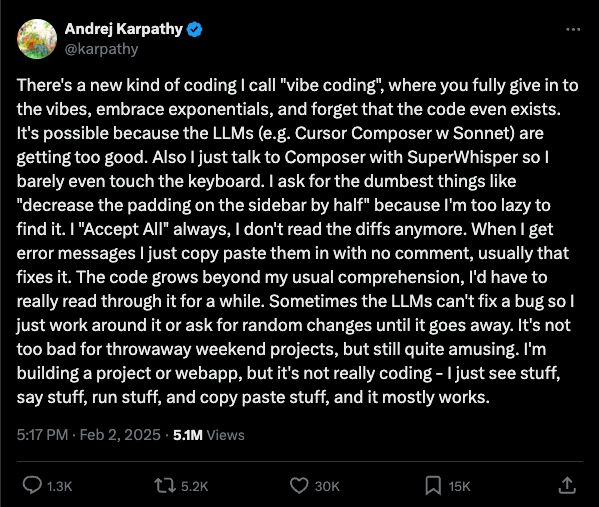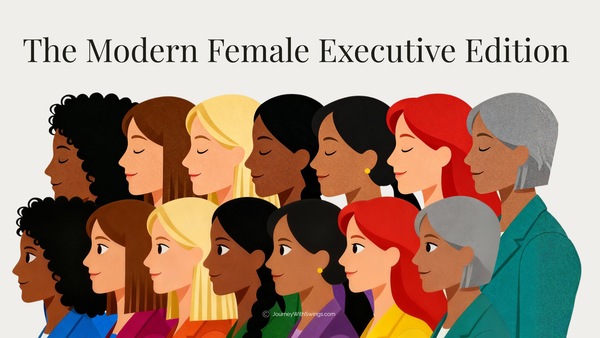v20 Vibe Coding Is a Trap: You’re Building Quicker, Just Not Smarter

Vibe coding is supposed to make everything easier. Faster prototypes. Fewer dependencies. Instant momentum.
And in some ways, it does. The first time I dropped a product prompt into a vibe coding tool and watched a working homepage appear, it felt like magic.
But here’s the trap no one talks about:
When building got easier, building the wrong thing got easier, too.
For founders with open calendars, vibe coding is a playground. For working moms building on the side? It’s either your secret weapon or a very elegant way to burn your limited hours.
When you only have 90 minutes of maker-time before your toddler’s nap ends or your parents-teacher call starts, a false start isn’t just frustrating, it’s devastating.
And in a life already governed by the 18-year parenting clock, optimizing my 90-minute window isn’t about productivity. It’s about psychological survival.

Last Year: Hire Devs, Burn Cash, Hope for the Best
Last summer, if you wanted to build something, the default was:
- Hire a dev agency or a contractor.
- Spend $10K - 50K building a prototype.
- Pray it worked.
- Expect to throw it away and start over.
That was the “lean” play for non-technical founder.
I wasn’t building products. I was trying building teams to maybe build products.
I spent more time gathering quotes from agencies than feedback from real people.
$10K here, $25K there just to get a prototype that, deep down, we all knew might be thrown away.
Everyone told me, “That’s just how it works.” You hire a dev shop, cross your fingers, and if you’re lucky? You get something that sort of works before realizing the idea doesn’t. I heard a horror story about someone who dropped $100K of his own money on a prototype, only to find out no one wanted what he built.
That shook me. From that moment on, I made a quiet promise to myself: I’m not spending six figures just to learn the hard way. It wasn’t just about saving money. It was about spending my time and my energy on the right thing:
When you outsource the build too early, you’re not buying speed. You’re buying confusion, delivered 4 weeks later.
Fast forward a year?
I’m shipping polished flows after bedtime. Not because I’m magic, but because the build phase is no longer the bottleneck thanks to vibe coding.
The real bottleneck? Knowing what to build, and why.

The Vibe Coding Term: Fast Forward to 2025
Fast forward to this year and I stumbled across a term that felt like it was made for me: vibe coding.
It popped up in Feb 2025, thanks to Andrej Karpathy (yep, the AI guy from Tesla and OpenAI). He tweeted about this new kind of building where you don’t really write code, you just vibe with it. Tell the AI what you want, it builds it, you tweak the parts that feel off. That’s it.

At first, it sounded like hype. Then I tried it.
I described a product idea in plain English, and a working homepage appeared in seconds. Magic? Kind of.
What makes vibe coding possible and actually useful isn’t just the tools. It’s the fact that LLMs have read basically the entire internet. That includes tons of websites, front-end frameworks, and messy code snippets. So when you prompt it, it’s drawing from millions of examples. That’s why web builds “just work.”
But here’s the catch: that magic doesn’t translate to mobile apps.
Unlike websites, mobile apps live in a walled garden. LLMs haven’t had access to the same volume of native iOS or Android code. So while spinning up a web prototype is easy, getting a functional mobile app still requires dev experience, design thinking, and a lot more patience.
So when I say I learned vibe coding, what I really mean is: I realized I could test real product ideas quickly, by myself, after bedtime without needing to hire a full team or write a single line of code.
It didn’t make me a developer. It made me dangerous enough to test the idea before wasting $100K learning it’s the wrong one.

The Most Convincing Lie in Vibe Coding
Every vibe coding tool gives you a homepage first. It looks beautiful. It feels like progress. But here’s what I learned:
A beautiful homepage is the most convincing lie in modern product building.
I clicked around and realized... Behind the shiny homepage? It was all vibes, no substance. Empty tabs. Broken flows. Zero logic. It was like walking into a beautiful restaurant only to find out the kitchen doesn’t exist. That’s when I realized:
The tool isn’t the work. My thinking is.
I had jumped straight to “build” without doing any of the work that makes the building actually matter. No user flows. No clarity on the core experience. No plan. Just vibes.
So I backed up. I wrote a scrappy one-page PRD. Sketched flows in Figma.
Asked real humans real questions. Then and only then did the tools become powerful. I wasted hours/days learning this. I hope you don’t.
The polished prototype didn’t come from vibe coding. It came from a Tuesday night wire framing session, a branding sprint between daycare and household chores, and the decision to stop skipping steps just because skipping was possible.
Turns out, vibe coding doesn’t save you from bad thinking. It just helps you make your mistakes look prettier, faster.

PRDs Aren’t Dead. They’re Just the New Prompts
When vibe coding first became popular, people loved to say Product Requirement Documents (PRDs) are dead. But here’s the truth: they’ve just had a glow-up.
Today, the PRD is the new prompt. The job hasn’t changed: get clear on what you’re building, who it’s for, and why it matters before you ask the AI (or an engineer) to do anything.
Here’s a real example: A product manager I know built an internal portal prototype without a single pixel from a UX designer. No design sprint. No dev time. Just a clean, well-scoped prototype, all delivered with a vibe coding tool.
How? He started with the most underrated power move in product: a solid PRD.
It was already aligned with key stakeholders. Every decision was thought through.
So when he dropped that doc into a vibe coding tool, the output wasn’t just usable, it was shockingly good. Because the thinking had already been done.
I learned this lesson the slow way. When my prompts were vague, my outputs were chaos. But when I took 30 minutes to write a one-page PRD? My tools stopped flailing and started building what I actually meant.
Your PRD doesn’t need to be fancy. But it does need to be clear.
These days, I keep it simple:
- Who is this for?
- What problem are they facing?
- What one thing am I testing?
- What does “working” look like?
A prompt without this? It’s like yelling “surprise me” at the AI chef.
You’ll get something. but probably not what you needed. It doesn’t have to be pretty. But it does have to be clear.
Because when your time is limited, clarity isn’t optional, it’s your only shot.
If your PRD is vague, your work are already wasted.

Vibe Coding Tools Landscape
At a recent vibe coding hackathon-style workshop led by Dan Olsen, he laid out a helpful map of the tool spectrum. It helped me make sense of the chaos.
It maps the AI-powered prototyping and coding tools across two axes:
- Horizontally, from less technical to more technical.
- Vertically, split between Vibe Prototyping (left) and Vibe Coding (right).
The left side features UI-first tools like Make by Figma, Lovable, and Bolt, great for designers and PMs. In the middle, tools like Replit and GitHub Copilot offer balance. On the right? You’re deep in engineer territory with Cursor, Claude Code, and Gemini CLI.
The colored bands show how these tools are delivered: browser-based UIs, IDE extensions, desktop apps, and command line tools. And that bottom gradient? It shows who’s using what: designers, PMs, and devs each leaning into different parts of the stack.
The big takeaway:
There’s no perfect tool, just the right one for where you are. If you’re not clear on what to build, even the best tool will just get you lost faster.
Few months ago I started on the right with Cursor. It almost broke me.
Then I swung back to the left, tried Make, then Lovable. Once I paired those with some proper prep (hello, PRD), things finally clicked.
But here’s what I noticed: vibe coding styles vary wildly.
Some folks at the workshop were obsessed with trying every new tool. They weren’t building products, they were benchmarking features. Others were more like me, less interested in how the magic happens, more focused on what we can get out of it. Can this tool help me validate an idea tonight? Cool. If not, moving on.
That’s when I realized: Vibe coding isn’t about choosing the perfect tool. It’s about knowing why you’re building, and picking the tool that helps you move just enough forward.
Tools are great. But they don’t replace thinking. And they definitely don’t replace talking to actual humans.

The Rise of the 10x Thinker
After all the tools, tests, and late-night flops, here’s what my actual build stack looks like now:
- Talk to real people (yes, even three is enough).
- Write a one-pager (PRD, not poetry).
- Sketch the flow in Figma (ugly is fine, just make it clear).
- Use vibe coding tools to build a scrappy prototype.
- Validate. Iterate. Decide.
- Loop in engineers (only when I know what we’re building, and why).
This isn’t about skipping engineering. It’s about respecting everyone’s time, yours, theirs, and especially your users’.
We used to glorify the 10x engineer. Now? I think the edge belongs to the 10x thinker. The one who understands the user. Write a sharp prompt. Build only what matters.
You don’t need to out-code anyone. You need to out-think everyone.
And if you're building in that weird window after bedtime but before burnout?
That clarity isn’t a bonus, it’s the only way this gets done.

Don't Just Vibe It
If you’re a PM, founder, designer, or parent doing this on the side:
- Don’t wait for a dev team.
- Don’t wait for the perfect time.
- But don’t skip the thinking, either.
Start small. Start now. Start right.
Because the only thing worse than building slow… is building fast in the wrong direction.
If this hits home, I’m turning it into a series. I’m breaking it down on LinkedIn: one post, one lesson at a time. More on time-starved building, UX shortcuts, and founder sanity, one prompt at a time.

🎧 P.S. Now My Newsletter Talks Back
Prefer to listen instead of read? I turned this exact newsletter into a podcast episode, so you can take it on a walk, a drive, or just hit play while hiding in your closet for ten minutes of peace. No judgment. Because sometimes hearing the words makes them land a little differently and you deserve to feel less alone, in whatever format works for you. Or if you want to share it with a friend who prefers podcast.
▶️ Listen to “Vibe Coding Is a Trap: Why AI Speed Makes Bad Ideas More Dangerous” on Spotify (Spotify link here).




